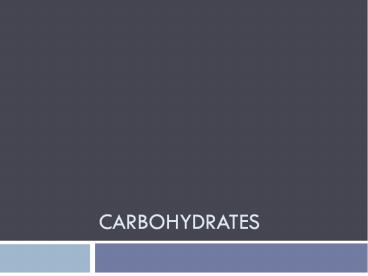Carbohydrates - PowerPoint PPT Presentation
Title:
Carbohydrates
Description:
... blood Complex carbohydrates Known as starches, fiber Made up of 100 s to 1000 s of simple sugars Found in grains, pastas, breads, cereals, ... – PowerPoint PPT presentation
Number of Views:187
Avg rating:3.0/5.0
Title: Carbohydrates
1
Carbohydrates
2
Carbohydrates
- What is the first thing that comes to mind?
- Carbohydrates
- Supply energy, vitamins, minerals, fiber and
phytochemicals - However, they are not all created equal.
3
Chemical Structure
- http//science9.files.wordpress.com/2007/04/diabet
es-glucose.gif
4
Carbohydrate Types
- Simple (sugars)
- Complex (starches and fiber)
5
Simple Sugars
- Monosaccharides
- Glucose
- AKA Dextrose
- The most abundant
- Supplies energy to cells
- Fructose
- AKA levulose or fruit sugar
- Galactose
- Found in lactose
6
Simple Sugars
- Disaccharides
- Sucrose
- AKA Table sugar
- May be highly refined
- Made up of one glucose and one fructose
- Lactose
- Milk sugar
- Made up of one glucose and one galactose
- Maltose
- Made up of two glucose molecules
7
Simple Sugars
- Found in honey, jam, jelly, syrup, table sugar
and some fruits - Measured in the blood
8
Complex carbohydrates
- Known as starches, fiber
- Made up of 100s to 1000s of simple sugars
- Found in grains, pastas, breads, cereals, legumes
and vegetables
9
Carbohydrate Digestion and Absorption
- Travels with carbohydrate
Insel Roth, 2010
10
Recommended Amounts
- Carbohydrates should be the bulk of daily diet.
- 45-65 of diet
- For 2,000 calorie/day diet 300 grams (or 60)
- BUT, choose them wisely
- Example wheat bread vs whole wheat bread
11
Food Carbohydrates
- The Good, The Bad The Ugly
- What foods contain carbohydrates?
- Which are better than others?
- What changes might you make in your own diet?
12
Fiber
13
Health Benefits
- Promotes healthy digestive system
- May lower blood sugar levels
- Lowers cholesterol
- Cancer prevention?
14
What is Fiber?
- A complex carbohydrate that the body can neither
digest nor absorb. - Not considered a nutrient
- Still has an important role in nutrition
- Two types of fiber
- Soluble
- Insoluble
15
Insoluble Fiber
- Roughage
- Promotes regularity
- Adds bulk
- Decreases the time that food spends in the
intestines - Examples wheat bran, whole-grains, vegetables,
fruits
16
Soluble Fiber
- Dissolves in water or other liquids.
- As it passes through the intestines, it forms a
gel - Promotes waste removal.
17
Fiber Your Intestines
- Fiber is your friend!
- Relieves and prevents constipation
- Wheat bran and oat bran are the most effective
- Start slowly though!
18
Fiber cholesterol
- Fiber binds with cholesterol to help remove it
from your system. - Less absorption decrease in cholesterol level
- This in turn, reduces risk of heart disease.
- Those who had a high intake of fiber had 40
lower risk of coronary heart disease (Harvard
Study) - Cereal with high fiber (grains) seemed the most
beneficial. - FDA approved claim May reduce the risk of heart
disease.
19
Fiber Diabetes (Type II)
- Fiber helps regulate blood sugar levels
- Slows emptying of the stomach which results in
slower release of sugar to the blood. - Glycemic Index
- Measures how quickly food is turned into glucose.
- Low glycemic foods cause the least spike in
blood sugar. - However, there are flaws in the glycemic index.
20
Fiber Weight Loss
- Fiber may help promote weight loss
- Less likely to overeat
- Makes a meal larger
- Consume fewer calories for the same volume of
food - People tend to eat slower
- Stay full longer
21
Recommendations
- 25 grams a day are recommended
- Americans do not eat enough fiber.
- How do you add fiber to your diet
Food / Fiber Grams Food / Fiber Grams
Split Peas / 16.3 g/cup Green beans / 4.0 g / cup
Raspberries / 8 g / cup Brown rice / 3.5 g / cup
Whole-wheat spaghetti / 6.3 g / cup Apple / 3.3 g / med. w/ skin
Oat bran muffin / 5.2 g / medium muffin Popcorn / 2.4 g / 2 cups
Broccoli / 5.1 g / cup Whole-wheat bread / 1.9 g / slice
Oatmeal / 4.0 g / cup Whole-wheat fig newtons / 2 g / 2 cookies!
22
Adding fiber to your diet
- Start slow!
- Drink water helps with digestion.
- Recommended water, no or low-calorie beverages
(unsweetened tea, diet soda) - Eat whole fruits instead of juices
- Replace refined grains with whole-grains
- Replace meats with legumes
- Experiment!
23
Fiber Food labels
- High fiber
- Must have 5 or more grams per serving.
- Good source of fiber
- 2.5 4.9 grams / serving
- More or added fiber
- At least 2.5 grams / serving
- Whole-wheat
- Does not always mean whole grain
24
Fiber Supplements
- Whole foods are generally always better
- Check with your doctor before using
- Examples Metamucil, Citrucel, FiberCon
- Fiber supplements
- May decrease effectiveness of some medications































